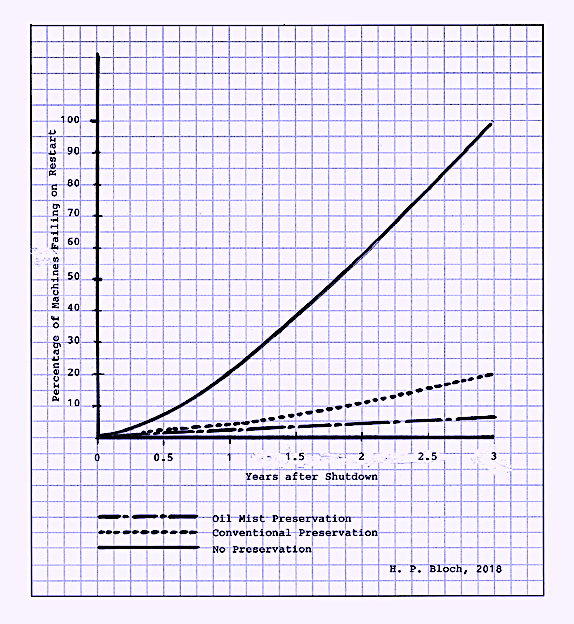information in this article relates to “mothballing” (i.e., storage protection or “hibernation”) of equipment that starts out clean. Chances are one gets away with implementing equipment preservation two or three weeks after the asset has been shut down or stopped. But there is a high probability that machines left unprotected for as few as six months will not respond fully to any method of belated storage protection. If preservation finally gets under way after six or more months of zero protection, there will be a measurable shortening of remaining equipment life before major repairs become unavoidable.
Editor’s Note:
This article is based on a chapter in the author’s book
“Optimized Equipment Lubrication, 2nd Edition, 2021;”
De Gruyter, Berlin/Boston, (ISBN 978-3-11-074934-2).
Additional chapters will be highlighted on this website in the future.
WHEN IT’S TOO LATE FOR STORAGE PRESERVATION
If a machine is shut down and left unprotected for a few months before protective measures are implemented, it is usually too late. In wet climates, water vapors will migrate into machines and condense to become free water. Dust, dirt, and desert sand will likely intrude in dry climates. All too often, rust will form and/or sand will cling to previously lubricated precision parts, such as bearings. In these cases, precautionary dismantling and examination are the only reasonable courses of action. Flushing will generally improve situations involving contaminant ingress, but only dismantling, cleaning, and, in some cases, replacing parts will be an assured solution.
Once a machine is completely disassembled, its individual parts can be cleaned and reused if solids wash off easily. If there is oxidation and rust, rust remover gels are available, but using them will require decisions made with considerable discernment. The gels must first be carefully applied and later thoroughly removed. There is no general rule; each case must be decided on its own merits, whatever the cost. For every dollar “saved” by leaving machines unprotected for two or three years, someone (or some part of the organization) will need to spend 20 or more dollars. These are the likely expense multipliers even before the cost of startup delays and the value of lost opportunities for profitable production and sales have been added.
HOW DEGRADATION PROGRESSES
Fluid machinery degradation is assumed to progress as shown in the empirical plot below (Fig. 1), which will be featured and discussed in our next article for The RAM Review. Nevertheless, it is intuitively evident that leaving machinery completely open to the elements (both inside and outside of a machine) will come at a price. One would not expect rusty machines to perform well in industrial processes after three years of unprotected storage. Therefore, the storage recommendations using oil mist described here, or the non-traditional methods described in other chapters of the book from which this article is excerpted (see Editor’s Note above), do not apply to machines that have been left unprotected for over six months.
 Fig. 1. Percentage of machines failing within
Fig. 1. Percentage of machines failing within
2 to 4 weeks of restart after shutdowns in wet or desert climates.
(Source: Heinz P. Bloch)
THE FLUSHING OPTION
Restarting machines after three years of unprotected storage is never recommended and may become a serious hazard to life and limb. The recommendations for equipment left unprotected in environments exposed to wet or fine solids for 6 to 12 months are relatively simple:
1. Flush the equipment with kerosene and drain the kerosene into a container.
2. Locate a linen patch (e.g., bedsheet-quality fabric made from fibers of the flax plant)
on a 100-gauge-wire- mesh-support grid between the equipment drain opening and inlet
to the kerosene-catching container.
3. Examine the linen patch after every fill and drain cycle, looking for rust or dirt particles
visible to the naked eye.
4. Continue and repeat the flush, drain, and examine cycle until no more particles can be
seen with the naked eye.
There is no reasonable alternative to this flushing procedure The speed of the procedure can be slightly accelerated by subjecting the machine’s exterior to hammer blows. These blows will dislodge some rust that may have clung to ferrous components. But even then, the Reliability Professional must be prepared to find rust and/or corrosion pits that, in the case of rust, could signify internal parts damage. Corrosion damage cannot be reversed; precautionary dismantling and rebuilding efforts that consist of parts repair or replacement are recommended
There are two other points to keep in mind:
1. In the unlikely event a machine was designed and manufactured with O-rings that will swell or
degrade when contacted by kerosene or commercial solvents, disassembly and O-ring replacement
will be required.
2. A commercial solvent can be used instead of kerosene. Alternatives to kerosene and/or commercial
solvents are usually offered by paint companies. Before accepting these commercial solvents or custom-
designed products, Reliability Pros should engage in an experience check with other users.
WORDS TO THE WISE
Storage protection as an afterthought is always a colossal failure of management. Occasionally, the failure results from Reliability Professionals not making a sufficiently compelling case for the outsized benefits that can be derived from finding, allocating, or borrowing the relatively insignificant amount of money needed for an outdoor storage yard and associated provisions.TRR
Editor’s Note: Click Here To Download A Full List Of Heinz Bloch’s 24 Books
ABOUT THE AUTHOR
Heinz Bloch’s long professional career included assignments as Exxon Chemical’s Regional Machinery Specialist for the United States. A recognized subject-matter-expert on plant equipment and failure avoidance, he is the author of numerous books and articles, and continues to present at technical conferences around the world. Bloch holds B.S. and M.S. degrees in Mechanical Engineering and is an ASME Life Fellow. These days, he’s based near Houston, TX.
Tags: reliability, availability, maintenance, RAM, electric motors, pumps, centrifugal air compressors, blowers, reciprocating compressors, gearboxes, bearing, lubrication, lubricants, oil mist



